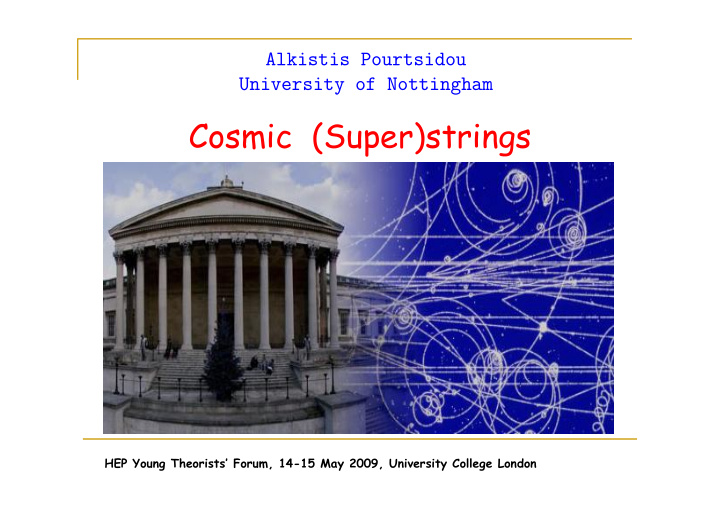



Alkistis Pourtsidou University of Nottingham Cosmic (Super)strings HEP Young Theorists’ Forum, 14-15 May 2009, University College London
Outline Formation of Cosmic Strings Cosmic strings in the early universe - evolution - network properties - cosmological consequences Cosmic superstrings - production - observability conditions and distinctive features Stability of cosmic strings Y-junctions
Production of cosmic strings - They arise in GUTs - 1D defects following U(1) symmetry breaking •As the temperature falls, energy not more sufficient to permit all fluctuations •The field has to choose one ground state This process leaves behind linear defects (cosmic strings)
Cosmic strings in the early universe : Evolution Effectively 1D, so can be modelled using Nambu-Goto action p R x 2 ) x 0 2 S = ¡ ¹ dtd¾ (1 ¡ _ Eom is the wave equation x ¡ x 00 = 0 Ä Long string intercommutation & loop production Intercommutation probability essentially 1 (they never pass through one another) intercommutation self-reconnection
Evolution of a network of cosmic strings (e.g.Allen & Shellard,Bennett & Bouchet) start with a network of long strings + loops and let it evolve •Loops decay emitting gravitational radiation •Long strings can survive •Scaling solution ½ s =½ m = 60 G¹
Cosmic strings in the early universe : Cosmological effects - Very thin (effectively 1D), very massive - Tension (mass per unit length) ¹ = 10 21 kg=m characterises the gravitational effects G¹ = 10 ¡ 7 - In the early universe, they would produce density perturbations ±½ ½ = G¹ = 10 ¡ 7 - Maybe an alternative to inflation? No: confrontation with data showed that they produce the wrong power spectrum
CMB power spectrum and Cosmic Strings •Strings unable to produce the acoustic peaks •Supporting role ~10% still possible G¹ < 10 ¡ 6 (e.g. Pogosian et al, Bevis et al)
The revival of cosmic strings through superstring theory Witten (1985) first considered the possibility of cosmic superstrings Problems energy scale too high (Planck scale), inhomogeneities too large produced before inflation – diluted unstable Conditions for Cosmic Superstrings (Dvali and Vilenkin, Copeland, Myers and Polchinski) - production after inflation, not too massive - cosmological stability - observability & distinctive features
The revival of cosmic strings through superstring theory Fundamental strings originally very different from cosmic: - energy scale much higher (Planck scale) - this means G¹ ¸ 10 ¡ 3 But, things can change radically when we consider compactification The braneworld scenario introduces the idea of warped spacetime ds 2 = e ¡ A ( y ) ( dt 2 ¡ d x 2 ) ¡ dy 2 Consequently, the effective tension can be ¹ eff = e ¡ A ( y ) ¹ 0 Thus tension sufficiently lower!
Brane Inflation (Burgess et al ; Jones, Sarangi & Tye ; Stoica & Tye) D-strings are formed in brane – antibrane annihilation Fortunately, no monopoles or domain walls (these would be cosmologically disastrous) In addition, F-strings can also be formed The energy scale of the formed strings is now 10 ¡ 12 < G¹ < 10 ¡ 6
Interesting new possibility: (p,q) string networks Two strings of different type cross Cannot always intercommute (not like gauge strings!) Produce pair of trilinear vertices connected by segment of string (1+2) This is a new and very distinctive feature !
Observational signatures Gravitational radiation -strong signal from cusps j _ x j = 1 -also signal from kinks -could be detected by LIGO, LISA (Blanco-Pillado)
GW emission from cusps (and kinks) If 10% of the loops are cuspy, gravitational wave bursts could be detected by LIGO and LISA Damour and Vilenkin (2004)
Summary and Conclusions Cosmic strings arise almost everywhere, from GUTs to string theory models Cosmic superstrings can be formed at the end of inflation, be stable and have sufficiently low tension Good possibility of detection through (mainly) gravitational radiation A window to string theory through cosmology !
On the stability of cosmic strings Y-junctions (hep-th/0904.2127) First modelled by Copeland, Kibble and Steer using Nambu-Goto action + junction conditions Field theory simulations from Bevis and Saffin using a U(1)XU(1) model Detailed comparison of Nambu-Goto and field theory approach using the butterfly configuration (N. Bevis, E. Copeland, P.Y. Martin, G. Niz, AP, P. Saffin, D. Steer)
Nambu-Goto simulations: Results Evolution depends on the ratio R = ¹ 0 2 ¹ 1 R=0.84 R=0.5
NG and field theory: Comparison - compare for (1,0) + (0,1) (1,1) -now compare for (1,1) + (1,-1) (2,0) Unstable Junction!
Conclusions Junctions are either stable or unstable The unstable ones decay (split) into 3 separate junctions which run away from each other depending on the local curvature Field theory simulations agree with Nambu-Goto, so can be used complementary when studying string networks
Recommend
More recommend